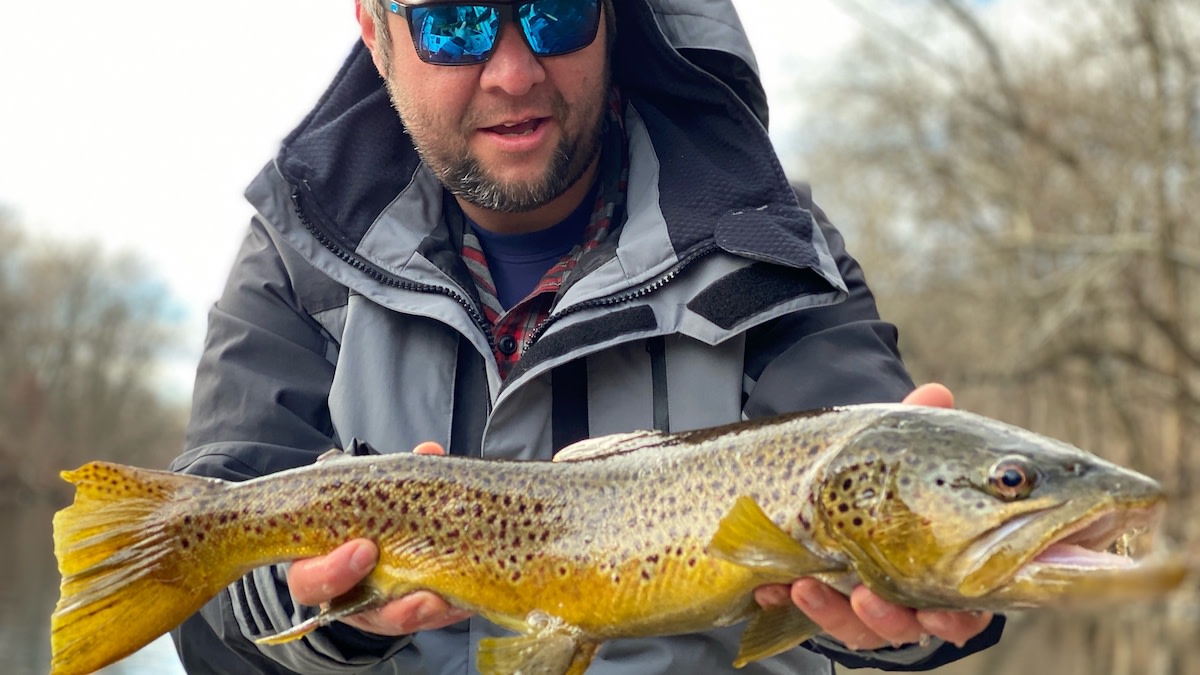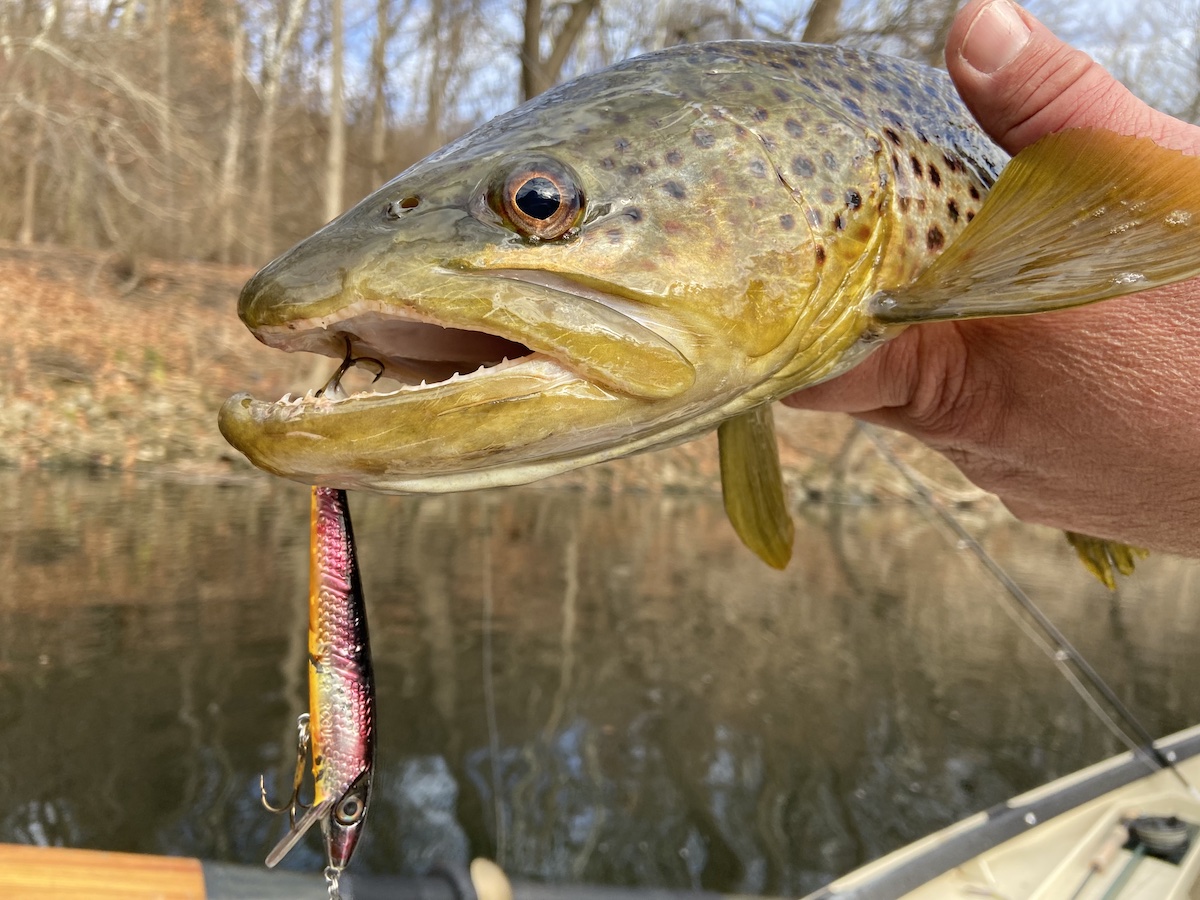
The Drunk & Disorderly is one of my all-time favorite trout streamers. It’s also one of the most complex patterns ever created. The placement of every feather, the order of each type of body material, isn’t simply cosmetic nor accidental. It has a reason. The mallard flank tied in flat over the tail, for example, helps the fly keel or stay oriented properly in the water. The incorporation of a rabbit strip at the collar adds necessary weight when wet, helping to keep the Drunk’s head down.
Trying to create that head, by the way, can lead to spouting off words at the tying bench so unholy they require a trip to confession. It’s made of tightly packed deer body hair that’s shaved into a sharp, downward-sloping wedge. Screw up that shaving process and at best you’ll have to start the head over. At worst, you’ll have a Drunk you think is ready for the river, only to get there and find the angle wasn’t steep enough, or your wedge is too asymmetrical, and the fly swims like total shit. But when you have a Drunk that’s up to code, it dives, darts, flashes, rolls, and jackknifes like no other streamer pattern. It’s one of the most productive big brown flies on the market, but it’s not as productive or effective as the lure that inspired it.
Noted Michigan fly guide Tom Lynch is the mastermind behind the Drunk & Disordely. In talking to Tom, I learned that it took several years of tinkering, tweaking, and trial and error to eventually land on the final Drunk recipe. In truth, however, while the design was very unique, the action wasn’t anything fish hadn’t seen before. Tom fully admitted his goal was to create a streamer that closely mimicked the movement of a classic Rapala Floater—one of the oldest and most trusted hardbaits in the world.
The wedged head of the Drunk mirrors the shape and angle of the Rapala’s plastic diving lip; the excessive tinsel incorporated into the fly is there to recreate the flash of a Rapala when it suddenly kicks to the side and reveals its full profile for a split second. It’s that particular dance move that Tom believed triggers big predatory browns into hammering a Rapala even when they aren’t actively feeding. But the Drunk & Disorderly also triggers a conundrum.

Blurred Lines Over the last 15 years or so, throwing big streamers for trophy trout has become so popular and trendy that it’s created a subculture within the broader fly fishing culture. “Streamer junkies,” they’re called, and full disclosure, I drank the meat-fly Kool-Aid years ago and continue to guzzle it down. As this subculture grew, it became increasingly obvious that new-age tyers like Tom Lynch were pulling inspiration for their flies from conventional lures that had existed for years, if not decades.
We now have pre-fabricated plastic and metal masks to glue on the heads of streamers. There are all manner of die-cut kick tails and paddle tails you can easily tie into a pattern. Just the other day I saw an Instagram video of a fly designed to work like the Wood Chopper, a classic prop bait popular with peacock bass fishermen.
To my eye, modern fly anglers have fully accepted flies inspired by lures like swimbaits and glidebaits, yet to the average meat chucker, the idea of leaving the fly rod at home and using a spinning rod to deliver actual swimbaits and glidebaits is unacceptable. If you fall into that mindset, you’re doing a great disservice to your fly game.
The best piece of fly fishing advice I ever got was from my good friend and veteran fly fishing writer Kirk Deeter: “Fly fishing shouldn’t be a way of life,” he told me. “A fly rod should just be another arrow in your quiver.”
He’s right. Furthermore, the best fly fishermen I know all started out conventional fishing. There is so much connective tissue between all forms of angling, yet rifts persist. As an example, if you grew up dunking worms for trout, you had a leg up on nymphing. You already had some knowledge of the way trout feed subsurface and where they position.
If you grew up chucking Panther Martin spinners like me, the learning curve was shortened when you cast your first Zonker. If at some point you “graduated” from spinners and worms to fly fishing permanently, there’s nothing wrong with that. I got so swept up in the streamer craze, it was the only way I wanted to target trout for four straight seasons. Then I started fishing the Lehigh River.

Back To School The Lehigh is a big, wide river. Compared to other more famous rivers in Pennsylvania, there are far fewer trout per mile. Although it was only a few hours from home, it wasn’t until my friend, Nick Raftas, started floating the Lehigh that I bothered with it, because the foot access is notoriously lacking and the wading ain’t easy.
We were exploring this river together, and despite working my shoulders out of their sockets ripping those big streamers, my first three floats produced one flash from a smaller trout and zero connections. I was ready to give up on the joint until a fourth visit following a bump in water flow got two decent browns pinned on my beloved Drunk & Disorderly.
Fast forward a few years. Little by little, we started to develop a pattern for success based on everything from flows to clarity to water temperature. But it was rare to stick more than one or two nice browns in a float. It left us wondering, is that all this river is going to give us? Are there just too few fish here? Most importantly, we questioned whether we were satisfied learning only what streamer fishing could teach us. Ultimately, we were not.
Nick is about as devout a fly guy as you’ll find, so I played the role of the heathen who suggested we run it with nothing but spinning rods, soft plastic swimbaits, jigheads, and hard jerkbaits. I won’t lie—I was really excited. I also won’t lie and tell you we positively hammered trout that day, because we did not. We caught four, but what mattered was where we caught them. Three of those fish came from those kinds of spots where you know trout live, but you never catch one.
We’d run hundreds of streamers through one particular deep chute, assuming the grab would come from the slower tailout. It wasn’t until I dropped a swimbait on a jighead into the upstream zone that I realized it was much deeper than I assumed, which meant a trout would have to be willing to shoot up much farther than I realized to grab a streamer just below the surface. I also got the bite on the jig at the head of the run, not in the less turbulent tail, which told me the fish did not set up here the way I thought they should based on the topside view. The next time we ran that stretch with fly rods, we knew to switch to a smaller, heavier pattern, and to drop it well above the bucket so it could sink into the head of the run. Swinging the low end as we had been for several seasons was effectively useless.
I look at a willingness to toggle between fly gear and spinning gear as the equivalent of enrolling in continuing education classes. In many regards, it’s a math lesson. If you’re floating with streamers, you might get three or four good presentations down a 50 foot section of bank. With a jerkbait, you might get 10. Naturally, the ability of spinning gear to cover more water faster equates to more fish, but there’s more benefit than extra fish in the net. You can “map” more effectively with a spinning rod, and within one season of leaning into conventional lures on the Lehigh, our success with streamers increased because we had a better sense of which specific nooks and crannies to hit and which sections of bank to skip.
Likewise, more time in the water means moving more fish, which provides more opportunity to study why a fish did—or did not—commit to a lure. Were you retrieving fast or slow? Did you implement pauses or keep it coming steady? Since so many streamer patterns we use mimic lures, it wasn’t hard to translate our observations about how fish reacted to jerkbaits and jigs into how we can work a streamer more effectively or differently.
Over a few seasons, a funny thing happened. Even though I’d grown up throwing conventional gear for trout, it was as though I’d discovered something new on the Lehigh. Instead of tying up experimental streamer patterns like I did when I first drank that streamer junky Kool-Aid, I found myself painting jerkbaits in the garage, trying to match the colors of productive flies or the specific pattern of the suckers in the river. I was as amped to throw them as I was the newest articulated streamer 5 years earlier.
But the end of the story is not that I no longer fly fish. It’s that I’ve embraced the different arrows in that quiver, and take all of them on the hunt. Sometimes I cast the fly rod all day, for no other reason than I feel like it. I just feel like fly fishing. More often, I’ll trade between flies, jigs, and jerkbaits stretch by stretch or even run by run. Those are the days I catch the most fish.
Nowadays, I don’t feel differently about a 25-inch brown I caught on a Rapala Floater than one I stuck on a Drunk & Disorderly. Maybe you would, and that’s OK. But if it’s the Drunk trophy you really want, you may achieve it faster by spending a little more time throwing the lure you can thank for its existence.





Conversation